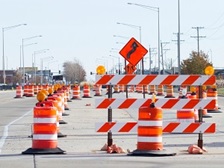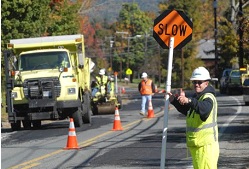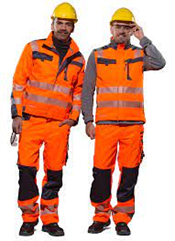Safety Tip #1: Setting up a Temporary Work Zone Using MUTCD

During National Work Zone Awareness Week, the Comp Alliance is recognizing the hazards of work zones with daily safety tips to keep employees safe. Our first tip focuses on how to properly set-up a temporary work zone. All work zones are different and offer unique challenges for flaggers and operators. Work zone administrators must be aware of these hazards and implement temporary traffic controls to avoid them so that workers can maneuver through the areas safely with equipment, and flaggers can adequately control traffic flow. Guidance from the Manual of Uniform Traffic Control Devices (MUTCD) for streets and highways must be followed for the proper set-up and operations within work zones. The manual is updated and published by the Federal Highway Administration (FHA). It is a compilation of national standards for all traffic control devices. This includes road markings, highway signs, and traffic signals. Highway and DPW Superintendents can review the latest MUTCD version from 2009 with 2012 updates by clicking here.
The MUTCD features work zone set-up recommendations on signage, positioning, markings, signals, flagger gear and responsibilities, low-volume road controls, and temporary traffic controls. For our Comp Alliance members, the information on the components of a temporary traffic control zone in part 6 would be most beneficial. It emphasizes the best practice for a typical road or lane closure situation. Utilizing the acronym ATBAT, you can identify the advanced warnings for drivers and pedestrians, workspace protections and work zone termination controls. ATBAT stands for the five sections of a work zone, including Advanced area, Transition, Buffer, Activity area, and Termination. Proper control devices installed for these five areas will help reduce accidents and injuries in work zones, regardless of their size and scope.
We recommend reviewing part 6 of the MUTCD before starting on any roadway project to ensure your municipality follows the manual and you are utilizing the best procedures to protect your work zone staff and the public.
Safety Tip #2: Importance of Flaggers - Controlling Traffic Flow

As part of the Comp Alliance’s recognition of National Work Zone Safety Week, we would like to remind all our members of the importance of flaggers who work these dangerous operations. In fact, the most vital part of any work zone operation is the flagger. They are responsible for the safety and protection of the workers as well as the public for safe navigation through and around a work zone.
Flaggers need annual training if they are new to the position. They should also undergo refresher training during the roadwork season. Training should be specific to the flagger position. They need to know where to be positioned, if the locations will change throughout the day, what devices they will need, what safety apparel to wear, what safety gear will be provided to them, and when and how breaks are handled. Breaks are important to keep flaggers fresh, alert and positively motivated to assist vehicle operators and pedestrians approaching work zones.
A good reference for appropriate flagger procedures can be found in the Manual of Uniform Traffic Control Devices (MUTCD) by clicking here. Members should review chapter 6E. This section goes over the use of hand signals, high-visibility safety apparel, locations to be stationed including vehicle sight distances, and hand signal devices.
Another important suggestion is to assign the right employees as your flaggers. Think about your staff and how they would deal with aggressive drivers and questions from the public. One reminder for flaggers is this – you are not a police officer. Should an individual refuse your direction and pass through a work zone unsafely, use your warning signal to workers of the hazard, take down the vehicle’s license plate number and a description of the driver. Report this information to a supervisor immediately. You may then resume your responsibilities of controlling traffic around the work site. The use of surveillance cameras at flagger locations can also help assist during the presence of unlawful or dangerous behaviors from the public.
As work zones are inherently dangerous for municipal workers, the use of trained, knowledgeable, and professional flaggers is vital. Remember to provide them with the tools they need to complete their jobs safely and effectively!
Additional highway department safety information is available on the Comp Alliance’s Municipal Academy. You can also check out Safety Source Online for important information on traffic control work zone safety, including courses SS21001AE and SS21003AE.
Safety Tip #3: PPE Required for Work Zones

For the Comp Alliance’s third safety tip during National Work Zone Awareness Week, we want to acknowledge the use of required Personal Protective Equipment (PPE) to keep employees safe in work zones.
According to the U.S. Bureau of Labor Statistics (BLS), the most common event associated with deadly occupational injuries is when a worker is struck by a vehicle or mobile equipment at a road construction site. The agency reports that 609 workers died from injuries in work zones between 2011 and 2015. About 46% (280) of those employees were killed because of incidents involving vehicles. Most of these employees were fatally hit by cars or dump trucks. Of the 79 workers struck by an automobile, the automobile was moving forward in 72 cases. Of the 49 workers hit by a dump truck, the dump truck was backing up in 40 cases. As such, work zone “runovers” and “back-overs” are considered the greatest hazard to roadway construction workers and the leading cause of death.
Wearing high visibility clothing is one important strategy to help reduce the number of struck-by deaths at road construction sites. Required PPE for work zone operations includes reflective safety vests, which must be worn during construction projects that remain open to the traveling public. In accordance with the Manual on Uniform Traffic Control Devices (MUTCD) 6D.03 (2009), all workers within the right-of-way who are exposed either to traffic or to work vehicles and construction equipment within the work zone shall wear high-visibility safety apparel that meets the Performance Class 2 or 3 requirements of the ANSI/ISEA 107–2004. Click here to review the MUTCD.
Additional PPE required for work zone employees includes hard hats, which are to be worn for protection during any work activity that may expose workers to a head injury. Safety glasses must be worn during any work activity that may expose workers to eye injuries. Workers can protect their eyes with safety glasses that have side shields, goggles, and/or face shields. Safety toe boots/shoes are also required when working in areas where there is a danger of foot injuries due to falling or rolling objects, exposure to piercing the sole, or protection against electrical or chemical hazards. For hand protection, glove selection should be based upon the tasks to be performed and the performance and construction characteristics of the glove material. Chemical and/or electrical exposures within the work zone present their own unique hazards and will require additional, specific PPE regulations.
Additional highway department safety information is available on the Comp Alliance’s Municipal Academy. You can also check out Safety Source Online for important information on traffic control work zone safety, including courses SS21001AE and SS21003AE.
Safety Tip #4: What Equipment Operators Need to Know
The Comp Alliance’s 4th Safety Tip during National Work Zone Safety Awareness Week focuses on the importance of equipment operators and what they need to know to stay safe while on the job. Roadway work takes planning, training, equipment, and cooperation. Some keys to keeping the equipment operators within your temporary traffic zones safe include prioritizing planning for the work, as well as confirming staff and equipment are available for the full length of the project.
During a temporary work zone project, all applicable staff should be trained on their duties and on situational awareness when working within the proximity of traffic and utilize spotters when necessary. Employees should also be trained on the warning alerts which may be initiated by flaggers or other personnel, personal protective equipment (PPE) to be worn, and other factors in the work zone environment.
Operators in work zones may be required to wear hearing protection due to increased noise levels, and therefore may be unaware when notifications of hazards are present. An alternate warning system (visual, person-to-person) should be incorporated under these conditions. When incidents or accidents do occur within the work zone, the temporary suspension of work may be required as well as documenting the incident for all affected employees.
Protections for workers within the activity area of a stationary or long-term temporary work zone will likely require barriers, barrier vehicles or similar rigid devices. Buffer areas protect workers from vehicle traffic and may provide a recovery area for the placement of off-use equipment, and a vehicle roll-ahead safe zone may also be necessary. Staging areas for supplies and equipment shall also be protected from vehicle traffic so workers can access them safely. Night work will require additional lighting equipment and retro-reflective signage which present their own issues including overhead obstructions and illumination distancing.
Additionally, the equipment in a temporary work zone also needs to be equipped with safety devices. Backing alarms must be active on all work zone vehicles and heavy equipment, as backing is conducted routinely and can alert nearby workers of approaching vehicles. Traffic flow within a work zone must be planned and understood by all affected staff. Spotters should be used when multiple equipment may be moved throughout a work zone, and communications clear between all operators and spotters.
The protection of operators within a work zone, whether it is short-term or long-term is vital to the success of maintaining safe roadways in and around your community. Click here to review the NYS Work Zone Traffic Control Manual for more information.
Safety Tip #5: Work Zone Safety Best Practices in Review
Throughout National Work Zone Awareness Week, the Comp Alliance has released safety tips to consider that will protect employees in and around work zones. The federal government and New York State have developed safety manuals on work zones due to the high hazard environment they pose, and the frequency and severity of injuries sustained. The federal document is called the Manual on Uniform Traffic Control Devices (MUTCD). We encourage our members to review part 6 within this document. New York has adopted rules from the federal document and incorporated them into the Work Zone Traffic Control Manual, which you can view by clicking here. You can also review the MUTCD by clicking here.
All temporary traffic operations require a keen eye to identify potential hazards and implement controls to minimize the risk to employees working in these areas. This week, the Comp Alliance has written about various exposures and controls for them. Street and road supervisors must continuously monitor the work zone operations to confirm that staff are safe and consider additional safety measures when necessary. Additional controls may include the use of surveillance cameras to oversee flagger operations or utilize local law enforcement’s traffic incident management programs to enforce traffic violations around your work zones. Any police presence can positively control your work zones with respect to passing vehicles and pedestrian traffic.
Work zones can include short-term mobile activities, short duration, short-term stationary, intermediate-term, and long-term stationary operations. Each present unique scenarios which require different protective devices and controls.
As work zones present challenges for municipal street and road crews, routine safety meetings to review best practices for active work zones should be conducted. Work zones in place for more than a day require updating staff daily to understand the remaining work tasks and responsibilities, as they likely have changed from the previous day. Review any safety issues which may have presented themselves from earlier work and implement corrective measures.
Safety measures for staff can also include routine breaks, flagger change-outs, operator change-outs, hydration stations, as well as wearing proper clothing and sunscreen. Implementing these protective measures and reviewing the latest information from the federal government and New York State will help promote a positive safety culture for all employees in work zones.
Additional highway department safety information is available on the Comp Alliance’s Municipal Academy. You can also check out Safety Source Online for important information on traffic control work zone safety, including courses SS21001AE and SS21003AE.
For more information, contact Director of Loss Control Robert Blaisdell at This email address is being protected from spambots. You need JavaScript enabled to view it., (518) 330-8591.

